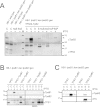System specificity of the TpsB transporters of coexpressed two-partner secretion systems of Neisseria meningitidis
- PMID: 23222722
- PMCID: PMC3562106
- DOI: 10.1128/JB.01355-12
System specificity of the TpsB transporters of coexpressed two-partner secretion systems of Neisseria meningitidis
Abstract
The two-partner secretion (TPS) systems of Gram-negative bacteria consist of a large secreted exoprotein (TpsA) and a transporter protein (TpsB) located in the outer membrane. TpsA targets TpsB for transport across the membrane via its ∼30-kDa TPS domain located at its N terminus, and this domain is also the minimal secretory unit. Neisseria meningitidis genomes encode up to five TpsAs and two TpsBs. Sequence alignments of TPS domains suggested that these are organized into three systems, while there are two TpsBs, which raised questions on their system specificity. We show here that the TpsB2 transporter of Neisseria meningitidis is able to secrete all types of TPS domains encoded in N. meningitidis and the related species Neisseria lactamica but not domains of Haemophilus influenzae and Pseudomonas aeruginosa. In contrast, the TpsB1 transporter seemed to be specific for its cognate N. meningitidis system and did not secrete the TPS domains of other meningococcal systems. However, TpsB1 did secrete the TPS2b domain of N. lactamica, which is related to the meningococcal TPS2 domains. Apparently, the secretion depends on specific sequences within the TPS domain rather than the overall TPS domain structure.
Figures





Similar articles
-
Two-Partner Secretion: Combining Efficiency and Simplicity in the Secretion of Large Proteins for Bacteria-Host and Bacteria-Bacteria Interactions.Front Cell Infect Microbiol. 2017 May 9;7:148. doi: 10.3389/fcimb.2017.00148. eCollection 2017. Front Cell Infect Microbiol. 2017. PMID: 28536673 Free PMC article. Review.
-
The polypeptide transport-associated (POTRA) domains of TpsB transporters determine the system specificity of two-partner secretion systems.J Biol Chem. 2014 Jul 11;289(28):19799-809. doi: 10.1074/jbc.M113.544627. Epub 2014 May 28. J Biol Chem. 2014. PMID: 24872418 Free PMC article.
-
Two-partner secretion systems of Neisseria meningitidis associated with invasive clonal complexes.Infect Immun. 2008 Oct;76(10):4649-58. doi: 10.1128/IAI.00393-08. Epub 2008 Aug 4. Infect Immun. 2008. PMID: 18678657 Free PMC article.
-
Two-partner secretion in Gram-negative bacteria: a thrifty, specific pathway for large virulence proteins.Mol Microbiol. 2001 Apr;40(2):306-13. doi: 10.1046/j.1365-2958.2001.02278.x. Mol Microbiol. 2001. PMID: 11309114 Review.
-
Unusual genetic organization of a functional type I protein secretion system in Neisseria meningitidis.Infect Immun. 2005 Sep;73(9):5554-67. doi: 10.1128/IAI.73.9.5554-5567.2005. Infect Immun. 2005. PMID: 16113272 Free PMC article.
Cited by
-
Biological Functions of the Secretome of Neisseria meningitidis.Front Cell Infect Microbiol. 2017 Jun 16;7:256. doi: 10.3389/fcimb.2017.00256. eCollection 2017. Front Cell Infect Microbiol. 2017. PMID: 28670572 Free PMC article. Review.
-
Cloning, Expression, and Immunogenicity of Fimbrial-F17A Subunit Vaccine against Escherichia coli Isolated from Bovine Mastitis.Biomed Res Int. 2017;2017:3248483. doi: 10.1155/2017/3248483. Epub 2017 Nov 29. Biomed Res Int. 2017. PMID: 29333439 Free PMC article.
-
Two-Partner Secretion: Combining Efficiency and Simplicity in the Secretion of Large Proteins for Bacteria-Host and Bacteria-Bacteria Interactions.Front Cell Infect Microbiol. 2017 May 9;7:148. doi: 10.3389/fcimb.2017.00148. eCollection 2017. Front Cell Infect Microbiol. 2017. PMID: 28536673 Free PMC article. Review.
-
The outer-membrane protein MafA of Neisseria meningitidis constitutes a novel protein secretion pathway specific for the fratricide protein MafB.Virulence. 2020 Dec;11(1):1701-1715. doi: 10.1080/21505594.2020.1851940. Virulence. 2020. PMID: 33315509 Free PMC article.
-
Relaxed specificity of BcpB transporters mediates interactions between Burkholderia cepacia complex contact-dependent growth inhibition systems.mSphere. 2023 Aug 24;8(4):e0030323. doi: 10.1128/msphere.00303-23. Epub 2023 Jul 27. mSphere. 2023. PMID: 37498085 Free PMC article.
References
-
- Jacob-Dubuisson F, Locht C, Antoine R. 2001. Two-partner secretion in Gram-negative bacteria: a thrifty, specific pathway for large virulence proteins. Mol. Microbiol. 40: 306–313 - PubMed
-
- Jacob-Dubuisson F, Fernandez R, Coutte L. 2004. Protein secretion through autotransporter and two-partner pathways. Biochim. Biophys. Acta 1694: 235–257 - PubMed
-
- Hayes CS, Aoki SK, Low DA. 2010. Bacterial contact-dependent delivery systems. Annu. Rev. Genet. 44: 71–90 - PubMed
-
- Tzeng YL, Stephens DS. 2000. Epidemiology and pathogenesis of Neisseria meningitidis. Microbes Infect. 2: 687–700 - PubMed
Publication types
MeSH terms
Substances
Associated data
- Actions
- Actions
LinkOut - more resources
Full Text Sources

